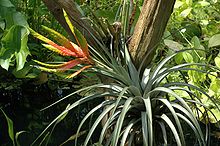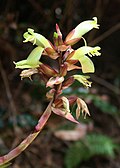| Tillandsioideae | |
|---|---|

| |
| Tillandsia fasciculata | |
| Scientific classification | |
| Kingdom: | Plantae |
| Clade: | Tracheophytes |
| Clade: | Angiosperms |
| Clade: | Monocots |
| Clade: | Commelinids |
| Order: | Poales |
| Family: | Bromeliaceae |
| Subfamily: | Tillandsioideae Harms[1] |
| Genera | |
Tillandsioideae is a subfamily of plants in the bromeliad family Bromeliaceae. This subfamily contains the greatest number of species (about 1,400). Most are epiphytic or lithophytic, growing in trees or on rocks where they absorb water and nutrients from the air. Spanish moss of the genus Tillandsia is a well-known species. Bromeliads in the genera Guzmania and Vriesea are the more commonly cultivated members of this subfamily.
Description[edit]
Nearly all bromeliads have specialized cell groups called trichomes which form scales on the foliage. The trichomes occurring on Tillandsioideae may cover the plants so completely that they appear grey or white, like Spanish moss. In addition to absorbing nutrients, the trichomes may serve to insulate the plant from freezing weather.
Plants in this group have smooth or entire leaf margins, unusual color and markings, with many producing fragrant flowers. All their leaves are spineless (unarmed) and their fruit is a dry capsule containing winged seeds which are usually dispersed by breezes. Feathery seed plumes help them to adhere to a suitable epiphytic surface for germination. This subfamily is probably the most derived with special adaptations for survival in very dry conditions, with many described as xerophytes.
Taxonomy[edit]
Phylogeny and classification[edit]
Tillandsioideae is the largest of the subfamilies of the family Bromeliaceae, with upwards of 1,400 species. Molecular phylogenetic studies from 1997 onwards repeatedly showed the monophyly of the subfamily. However, the division of the subfamily into genera has varied considerably. A 1997 monograph used six genera: Catopsis, Glomeropitcairnia, Guzmania, Mezobromelia, Tillandsia and Vriesea. Other genera were later segregated from Tillandsia and Vriesea, of which three, Alcantarea, Racinaea, and Werauhia, gained general acceptance. Molecular phylogenetic studies from 2001 onwards showed that Mezobromelia, Tillandsia and Vriesea in particular were not monophyletic, and that the circumscription of other accepted genera was problematic in relation to these three genera. A major monograph published in 2016 used plastid and nuclear DNA as well as morphological characters to produce a new phylogeny and classification for the subfamily. Their preferred cladogram is shown below.[2]
| Tillandsioideae |
| ||||||||||||||||||||||||||||||||||||||||||||||||||||||||||||
The 2016 study was unable to fully resolve the two genera Cipuropsis and Mezobromelia because the type species of Cipuropsis, Cipuropsis subandina, was not available for study.[2] In 2017, Gouda added a new species to Cipuropsis (Cipuropsis asmussii) and clarified the distinction between Cipuropsis and Mezobromelia, leaving the former with three species.[3] As of November 2022[update], the Encyclopaedia of Bromeliads accepted both genera, as well as the closely related Josemania,[1] whereas Plants of the World Online treated all three in the single broadly defined genus Cipuropsis – marked as Cipuropsis s.l. on the cladogram above.[4] Waltillia was not included in the 2016 study as a separate genus, but is accepted by both the Encyclopaedia of Bromeliads[1] and Plants of the World Online.[5]
The classification produced by the 2016 monograph uses four tribes, Catopsideae, Glomeropitcairnieae, Tillandsieae and Vrieseeae, the last of which is divided into two subtribes, Cipuropsidinae and Vrieseinae.[2]
Genera[edit]
Genera placed in the subfamily as of October 2022[update] by the Encyclopaedia of Bromeliads are listed below.[1] Plants of the World Online did not accept Josemania and Mezobromelia, sinking them into Cipuropsis.[4] Tribe and subtribe placements are from the 2016 monograph and the Encyclopaedia of Bromeliads.[2][1]
| Image | Genus | Tribe and subtribe |
|---|---|---|
 |
Alcantarea (E.Morren ex Mez) Harms. | Vrieseeae: Vrieseinae |
| Barfussia Manzan. & W.Till | Tillandsieae | |
 |
Catopsis Griseb. | Catopsideae |
| Cipuropsis Ule | Vrieseeae: Cipuropsidinae | |
 |
Glomeropitcairnia | Glomeropitcairnieae |

|
Goudaea W.Till & Barfuss | Vrieseeae: Cipuropsidinae |
| Gregbrownia W.Till & Barfuss | Tillandsieae | |
 |
Guzmania Ruiz & Pav. | Tillandsieae |
| x Guzlandsia Gouda (Guzmania × Tillandsia) | Tillandsieae | |
| Jagrantia Barfuss & W.Till | Vrieseeae: Cipuropsidinae | |
| Josemania W.Till & Barfuss | Vrieseeae: Cipuropsidinae | |

|
Lemeltonia Barfuss & W.Till | Tillandsieae |

|
Lutheria Barfuss & W.Till | Vrieseeae: Cipuropsidinae |

|
Mezobromelia L.B.Smith | Vrieseeae: Cipuropsidinae |

|
Pseudalcantarea (Mez) Pinzón & Barfuss | Tillandsieae |
 |
Racinaea | Tillandsieae |
| Stigmatodon Leme, G.K.Br. & Barfuss | Vrieseeae: Vrieseinae | |
 |
Tillandsia L. | Tillandsieae |
 |
Vriesea Lindl. | Vrieseeae: Vrieseinae |
 |
Wallisia (Regel) É.Morren | Tillandsieae |
| Waltillia Leme, Barfuss & Halbritter | Vrieseeae: Vrieseinae | |
 |
Werauhia J.R.Grant | Vrieseeae: Cipuropsidinae |

|
Zizkaea W.Till & Barfuss | Vrieseeae: Cipuropsidinae |
References[edit]
- ^ a b c d e Gouda, Eric J.; Butcher, D.; Gouda, C.S. (2022), "subfam. Tillandsioideae Harms", Encyclopaedia of Bromeliads, Utrecht University Botanic Gardens, retrieved 2022-10-26
- ^ a b c d Barfuss, Michael H.J.; Till, Walter; Leme, Elton M.C.; Pinzón, Juan P.; Manzanares, José M.; Halbritter, Heidemarie; Samuel, Rosabelle & Brown, Gregory K. (2016-10-13), "Taxonomic revision of Bromeliaceae subfam. Tillandsioideae based on a multi-locus DNA sequence phylogeny and morphology", Phytotaxa, 279 (1): 1, doi:10.11646/phytotaxa.279.1.1
- ^ Gouda, E.J. (2017), "A new species of Cipuropsis, and some remarks about this recently resurrected genus", Journal of the Bromeliad Society, 66 (2): 75–86
- ^ a b "Cipuropsis Ule", Plants of the World Online, Royal Botanic Gardens, Kew, retrieved 2022-10-27
- ^ "Waltillia Leme, Barfuss & Halbritt.", Plants of the World Online, Royal Botanic Gardens, Kew, retrieved 2022-11-01
- Black, Robert J.; Bijan Dehgan. "Bromeliads". Electronic Data Information System. University of Florida IFAS Extension.
- "Superorder Commelinanae". Texas A&M University Bioinformatics Working Group. 1999-04-03.
- Luther, H. E. (2008) An Alphabetical List of Bromeliad Binomials, Eleventh Edition The Marie Selby Botanical Gardens, Sarasota, Florida, USA. Published by The Bromeliad Society International.